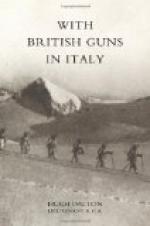On the right of the British, the French Infantry, though furiously assaulted, never, I believe, budged an inch. On the right of the French, the Italians were momentarily driven from Col Valbella, Col del Rosso and Col d’Echele, which they had won in January, but retook all three a few days later.
But we in the Battery knew nothing of all this at the time. We knew only that we had to open fire on our counter-preparation target. The gunpit of our No. 1 gun near the cross-roads was in low-lying ground, now so full of gas that one could hardly see one’s hand before one’s face. Fortunately we could achieve the rate of fire required by using three guns only, so we left No. 1 out of action for the time. The enemy’s bombardment, as far as we were concerned, was beginning to slacken a little, but was still heavy. The Major, out on the road with a signaller mending wire, was hit in the face with shrapnel. It turned out, happily, not a serious wound, but at the time it looked less hopeful. He went down the mountains in the same Field Ambulance with the young Colonel of the Sherwood Foresters, of whom I have already spoken.
There was an abandoned Field Ambulance in the road, half in the ditch, with the engine still running. The driver had found the shelling too hot to stay. There was no one inside it, but we got a couple of stretchers from it. And we had need of them. No. 4 gun, my own gun, which was nearest to the road, suffered most severely. Seven of the detachment on this gun were hit, not all at once but, what is apt to be much more demoralising, at intervals of a few minutes. A Bombardier was in charge of the gun that day, no senior N.C.O.’s being available. He showed a very wonderful coolness and courage. Shells were bursting all round the gunpit, and sometimes in the gunpit itself. But the rate of fire never slackened. Every now and again the cry was heard “another casualty on No. 4!” and stretcher bearers would start down the road from the Command Post. But, each time, almost before they had started, came the deep report of another round fired. No casualties and no shelling could silence her. At one time this Bombardier had only two other men to help him work the gun. And both of them were as undismayed as he. He won the Military Medal for his gallantry that day, and I was very proud of him and of No. 4.
The Brigade Chaplain appeared in the course of the morning and gave a hand in carrying the wounded away on stretchers. It was outside his official work and I give him all credit and respect for the help he gave us. But one N.C.O. in the Battery, with the plain speaking that comes naturally in the face of common danger, said to him, “Well, Sir, we never thought much of you before, either as a man or as a preacher, but we’re glad to see you here to-day doing your bit.”
The Austrian gunners had a fine sense of discrimination in their targets. The wooden hut, in which I and two of my brother officers used to sleep, had been hit two or three times that day, and much of our kit had been destroyed. So had both volumes of Morley’s Rousseau, which were on a shelf over my bed, leaving behind only a few torn and scattered pages. Much damage had also been done to a collection of Pompeian photographs of great historical interest. But Baedeker’s Northern Italy, which lay alongside, had not been touched!




